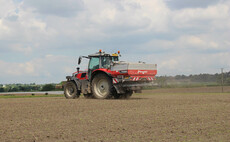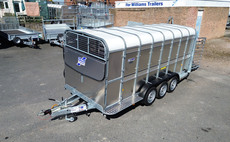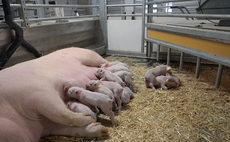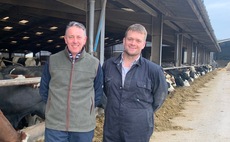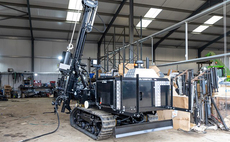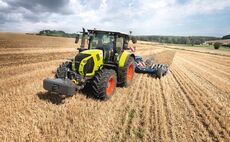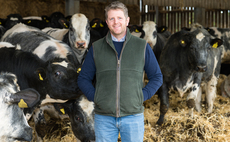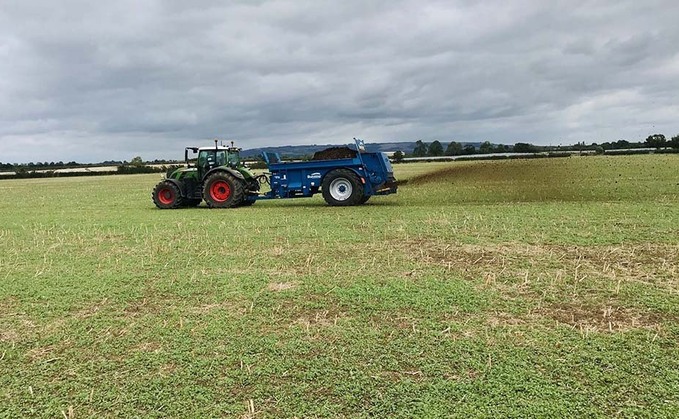
Bunning's most compact rear discharge spreader is hard at work for one Welsh poultry enterprise. Jane Carley finds out how the spreader is fitting in with the farm business.
Operating your own muck spreader offers increased flexibility, but many machines are just too big for a smaller farm or tricky terrain, especially a machine capable of handling lighter materials.
When Huw Mackinnon added a free-range poultry enterprise alongside his dairy business at Plas Tirion near Caernarfon three years ago, he knew that a different approach would be needed to muck handling.
He says: "We have a 100-head dairy herd plus followers and three years ago we added 32,000 free range layers. We use a Shelbourne Reynolds Powerspread for the dairy muck as it is 90 per cent liquid, but I needed a rear discharge spreader to apply the lighter chicken litter material, so I researched the market."
He soon found that most machines were just too high in capacity for his requirements.
"One of the companies that I contacted was Bunning Engineering and they explained that they had a smaller rear discharge spreader in development, complete with the beaters and spinning discs needed to spread light materials.
Dealer
"I had looked at their larger machines and saw how well built they were, so I asked my local dealer Menai Tractors to help source the new spreader. It arrived in spring 2018, the first to be delivered on-farm."
The new machine uses the company's established body and floor construction, the same as the established Bunning TVA models. In addition, it features a new design of horizontal beater and spinning disc spreading mechanism, using the same one-metre diameter Hardox steel spinning discs as those fitted to larger HBD models.
Durability is boosted by heat-treated boron beater flighting and reversible boron beater blades, plus heavy-duty beater roller drive chains.
Mr Mackinnon's Farmstar 80HBD has an eight tonne capacity, able to carrying up to 10.2 cu.m of material, is fitted as standard with a single axle rated to 13t and is equipped with 406 by 120mm brakes with slack adjusters.
"It will spread chicken litter to 24m and is easily adjustable to apply 2.4-3.6t/hectares to silage aftermaths, which we do three times a year, or up to 9.6t/ha for single applications on pasture or reseeds," Mr Mackinnon says.
Some 17t per week are applied to land at Plas Tirion from March to October and the poultry manure is also in demand from other local farms.
He says the spreader is easy to use, simply by weighing the load on a weigh bridge for calibration, and setting the floor speed on the in-cab control.
"It produces a very consistent spread pattern, which is evidenced by the even grass growth after application," he says.
Mr Mackinnon notes that the nutrient benefit of the muck has reduced the amount of mineral fertiliser needed, especially P and K.
The region's ideal growing conditions mean that grass re-growth after cutting is rapid, so he needs to get back on the field with the spreader within two weeks of mowing before the sward gets too tall.
"Having our own spreader gives us that flexibility of application; there is no guarantee that you could get contractors exactly when you wanted them in that tight time window."
Conditions
The comparatively light weight of the spreader means that it can also travel in Wales's moister conditions, especially as it is fitted with wide 650/65 R30.5 BKT tyres.
"The only downside of the wide tyres is that it can be a little tight getting down some of our narrow lanes," he adds.
It is pulled by a 130hp John Deere 6130R, the farm's general workhorse tractor, which he says handles it well even on the steeper ground. Loading height is just under 2m, so it is easily filled with the farm's telehandler.
Mr McKinnon reports no issues in three seasons' work. All servicing is carried out in-house, with automatic lubrication on the beater driveline keeping manual greasing to a minimum.
In conclusion, Mr McKinnon says: "We had not used this type of spreader before, so both Bunning and Menai Tractors have been very helpful with setting it up and getting the best out of it. It does not work that hard so we would expect to get many years of use out of it, especially given its solid build quality."
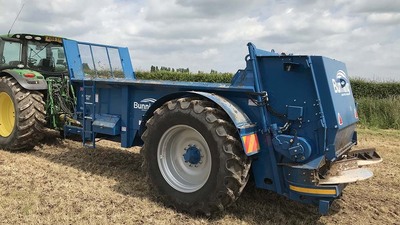
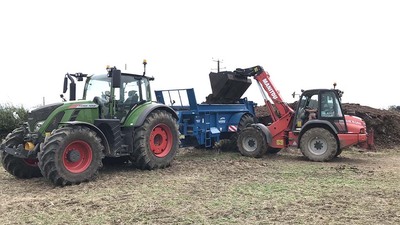
Muck spreader specifications:
Model: Bunning Farmstar 80 HBD
Capacity level: 6cu.m
Capacity heaped: 8cu.m
Capacity with extensions: 10.2 cu.m
Carrying capacity: 8,000kg
Number of axles: One
Floor drive: hydraulic
Body size (interior): 4,500 (L) x 1,500 (W) x 785mm (H)
Floor chain thickness: 16mm
Standard tyre size: 18.4/340 R14
Spreading mechanism: spinning discs and single horizontal beater
Spread width: Up to 30 metres
Pto speed: 1,000rpm
Unladen weight: 5,200kg
Retail price: £30,950


















